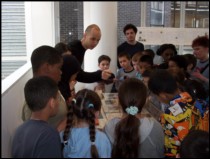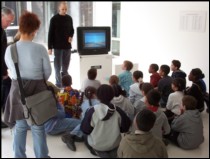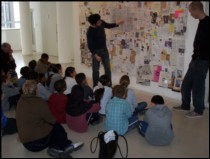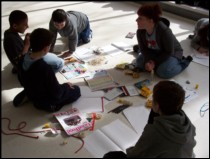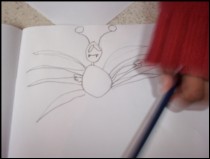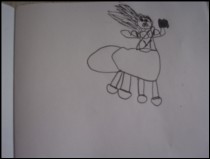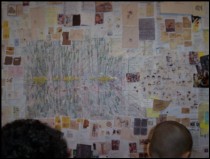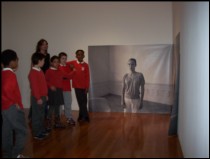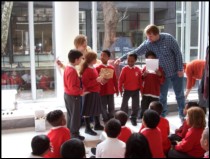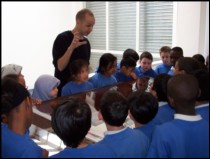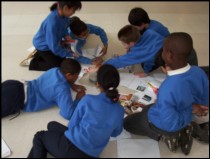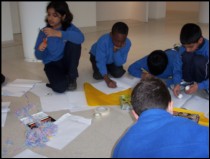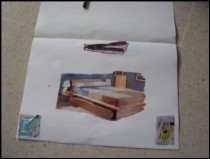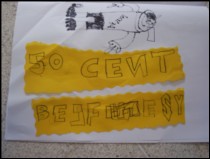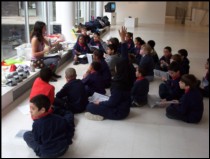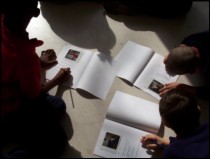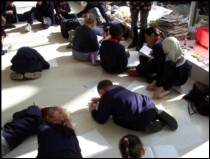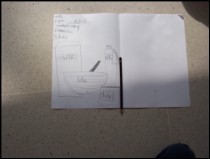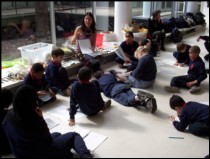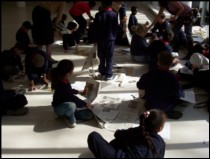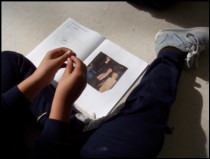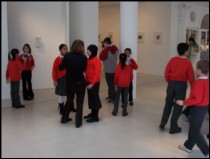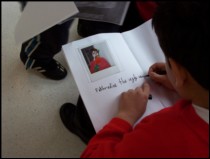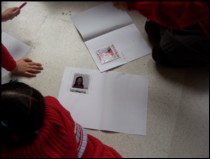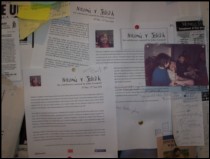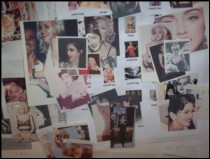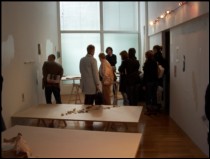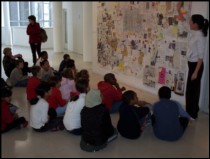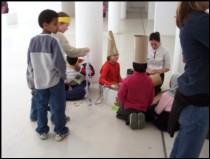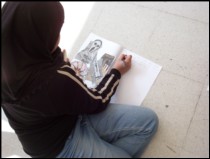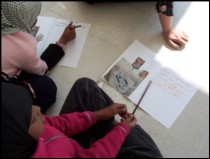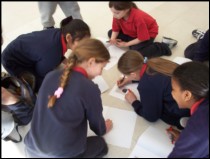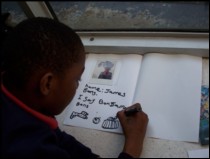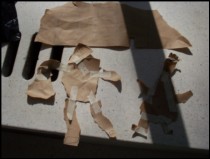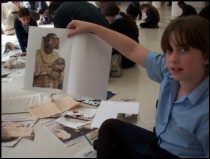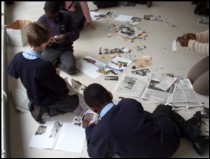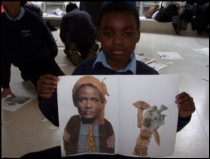|
See davidgauntlett.com for new stuff. |
 |
![]()
Project: THE PASSPORT OF ME
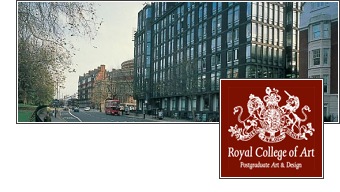 This
project was developed by Peter Bonnell and David Gauntlett as part of the educational
programme accompanying the
exhibition This Much is Certain at the Royal
College of Art, London, in March-April 2004.
This
project was developed by Peter Bonnell and David Gauntlett as part of the educational
programme accompanying the
exhibition This Much is Certain at the Royal
College of Art, London, in March-April 2004.
This Much is Certain explored the use of documents and documentaries by artists and others, in space, time and text.
The Passport of Me gave young people the opportunity to create documentation about themselves, in the form of a 'passport' which included a polaroid photo and other visual information added by the passport holder.
![]()
THIS MUCH IS CERTAIN
- WORKSHOPS REPORT
by Peter Bonnell
|
Introduction Each year graduating students of the MA Curating Contemporary Art (CCA) organise a major international exhibition in the Royal College of Art galleries. This final exhibition usually attracts around 4000 visitors, and has hosted many successful tours, outreach programmes, and education programmes. The 2004 exhibition was entitled This much is certain and was a four part project that consisted of a catalogue, an exhibition and a film and talks programme that took place in the Royal College of Art galleries from 13 March to 4 April. Together the four parts that comprised This much is certain explored the significance of the document and the documentary in contemporary art and contemporary society, focusing on how documents are usually relied upon by the public to be trustworthy and factual. Recent political events like the Hutton inquiry, however, make it increasingly difficult to take these documents at face value. This much is certain included works by established British artists such as Dexter Dalwood, Iain Forsyth and Jane Pollard and Jeremy Deller. International artists included Aernout Mik, Emily Jacir, Kiersten Pieroth, Gerard Byrne, John Massey, Miriam Bäckström, Huang Yongping and Jeffrey Vallance, and the Los Angeles based organisation the Museum of Jurassic Technology. The exhibition also included works by emerging British artists Daniel Baker and Jamie Shovlin. For further information on all of the artists, and the film and talks programme please visit: www.cca.rca.ac.uk/thismuchiscertain. The Education Programme The education programme for This much is certain was organised by CCA students Peter Bonnell and Jennie Syson and was intended to run in conjunction with and be complementary to the exhibition. The aim of the education programme was to provide a series of free workshops for primary school children, as well as a series of guided tours designed for college and university level students. Once funding was secured from the John Lyons Charity the education team set about inviting schools and colleges to participate in the education programme. Over 200 letters and emails were sent out to schools and colleges in the London boroughs of Barnet, Brent, Camden, the City of Westminster and the Royal Borough of Kensington and Chelsea. Demand was especially high for the workshops, and the decision was made to add an extra two sessions making a total of eight, with almost a dozen schools requesting to be placed on a waiting list. Once the five participating primary schools – Preston Park (Brent), Ashburnham, Middle Row (both Kensington and Chelsea), All Saints (Barnet) and Kingsgate (Camden) – had confirmed their attendance, the education team contacted experienced workshop leaders. These were: Gayle Chong Kwan, an artist who has worked extensively with the education programme at the Serpentine Gallery; the artist Alex Schady, who has a great deal of experience as a workshop leader at the Whitechapel Art Gallery and Sally Barker, also an artist who has worked with the education programme at the Serpentine Gallery. In addition, two of the exhibiting artists were invited to participate: Jamie Shovlin presented his work to the children in the workshops, and Daniel Baker was asked to participate in the guided tours for college students, also presenting and discussing his work. In addition each member of the curating team was also asked to lead a tour, based on a basic script provided by Peter Bonnell. The Workshops The workshops were aimed at stimulating the creativity of participating children, and to provide an interesting opportunity for engaging them in themes relating to:
The workshops consisted of an introductory tour of various works in the exhibition, creative activities (such as drawing, photography and writing) and a final discussion of the work that the children had made, and its relation to works in the exhibition. The workshops were targeted at Key Stage 1 and 2 children (particularly 7 – 11 year olds) in an attempt to emulate the aims and objectives stipulated in the National Curriculum. The workshops began with the children being taken on a tour of the exhibition by the workshop leader, focusing on and generating discussions of the work of selected artists. The basic ideas behind particular artworks were explained to them, emphasising the themes and concepts of documentation, storytelling, identity, the news media, truth/ fiction and the concept of evidence gathering. Activity: The Passport of Me The education team contacted Professor David Gauntlett of Bournemouth University Media School, who had come to their attention due to his participation in workshops for young people for the exhibition Pin-up: Glamour and Celebrity Since the Sixties, which took place at Tate Liverpool in 2002. In collaboration with the education team Professor Gauntlett identified the passport as being one of the most recognisable and familiar documents in society – a document filled with personal facts which contain information about such things as the holder's birth date, place of birth and vital statistics, and are always accompanied by a photograph. With this in mind the 'Passport of Me' became an eight-page A4-sized booklet designed to mimic the style of a passport. During the workshops the children were asked to take a Polaroid photograph of themselves. They then stuck the resulting photograph in the back of the passport, accompanied by a series of questions which they were encouraged to answer, devised by workshop leader Alex Schady and Peter Bonnell (for a list of these questions, see below). The remaining pages were used for drawings and collages that the children created during the workshops, relating to themes of truth and fiction, narrative, etc. Some pages remained blank, so that the children could take the 'passports' away and fill them in with other artworks about themselves either at school or at home. Workshop Content Prior to each workshop taking place a planning session was arranged between the workshop leaders and the education team. This was to assure that the themes that appeared integral to the exhibition – such as the exploration of the document and its relation to truth and fiction, storytelling and evidence, etc, were present at all times in the workshops. The education team stressed that each workshop leader should focus on these themes, as well as augmenting them with ideas prevalent in their own work. The following section, entitled 'The Workshop Participants', consists of individual accounts by each workshop leader or assistant (in the case of Jamie Shovlin) of the content of the workshops or tours they participated in. The members of the education team acted as assistants to the workshop leaders, taking the opportunity to explain why they as part of the curating team had selected the works to appear in the exhibition. The Workshop Participants Gayle Chong Kwan led three workshops – one each with Middle Row and Kingsgate and one with All Saints. Alex Shady led two workshops – with Kingsgate and Preston Park, and Sally Barker led three workshops – one with Middle Row and two with Ashburnham. Jamie Shovlin assisted in three workshops – one each with Kingsgate, Ashburnham and Middle Row, where he was able to discuss at first-hand his work directly with the children. Peter Bonnell assisted the workshop leaders in all eight workshops – ensuring that themes relevant to the exhibition were adhered to, and Jennie Syson assisted in one workshop. The following accounts are written by the workshop leaders and the participating artist: Gayle Chong Kwan
Alex Schady
Sally Barker
Jamie Shovlin
The Guided Tours The guided tours were intended to provide college level students – HND, Foundation, BA and MA level in art and design and art history – the opportunity to engage directly the themes discussed within the exhibition and film programme. The tours also provided an opportunity for the curating team to discuss these ideas with interested groups. There were ten tours in total, eight of which were led by two members of the curating team. Peter Bonnell led three of these tours, and participated in one more. In addition to the curating team, artist Daniel Baker was asked to participate in two tours – one of which, for the West London College situated in Hammersmith, was funded by grant money provided by the John Lyons Charity. Baker has contributed the following to this report: Daniel Baker
Conclusion Without the generous financial assistance of the John Lyons Charity the education programme for This much is certain would not have been a success – and quite possibly may not have existed at all. In total the £1,800 provided by John Lyons allowed more than 200 primary school children in London – some from deprived boroughs – to enjoy and engage with contemporary art works. As can be seen with the evaluation questionnaires completed by participating teachers, the workshops were a great success – with many of the teachers acknowledging that the content of the workshops was reflected in the themes and ideas they were exploring in the classroom. Doreen Morgan, arts co-ordinator of Ashburnham primary informed the education team that the pupils who participated in the workshops had continued to work in the 'Passport of Me' booklets after they left the Royal College of Art galleries, and that they had produced some "interesting work." The guided tours, although much more informal, were also considered a success. Max Ellis, Foundation tutor on the art and design course at West London College commented that he and his students had "…found it a most stimulating visit", and that the tour they participated in was "most informative." Perhaps the most rewarding element of the education programme was the opportunity for the education team, and by extension the rest of the curating team, to see the excited reactions and intellectual engagement of the children with the contemporary works on display. This also extended to the participating college students, many of whom are studying to become artists, or to work in the arts in some other capacity. Although the education programme was small in comparison to the exhibition and films programme, it nonetheless succeeded in facilitating a relationship with young people, and hopefully fostering an increased appreciation and understanding of contemporary art. |
|
![]()

